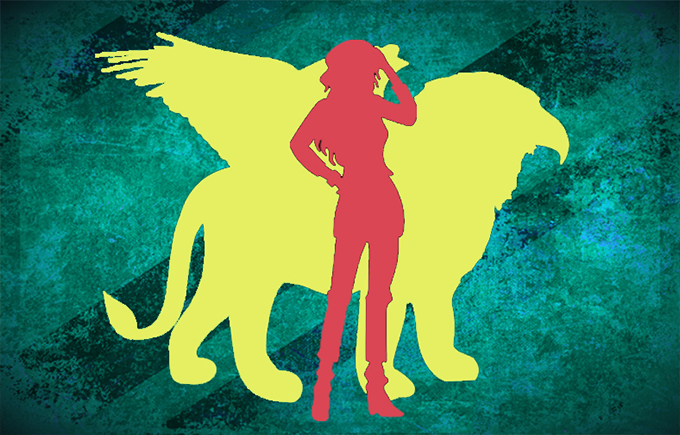Panquila Chrysaeteos : Griffin
| Kingdom: | Animalia |
| Phylum: | Chordata |
| Class: | Mammalia |
| Family: | Panthera |
| Genera: | Panquila |
| Species: | Chrysaeteos |
The griffin is both a feathered animal and a quadruped; its body is like that of a lion, but it has wings and the face of an eagle. Griffins are hostile to horses and attack any man they see. Isidore of Seville [7th century CE] (Etymologies, Book 12, 2:17). Found at The Medieval Bestiary website.
The Griffin
Sexually active as early as 2 years old, gestation is only 6-8 months and cubs are fully fledged by 18-10 months old. Young are capable of actual flight from the nest around 12-14 years, but they can't fly for sustained periods until around 3 years old. Female griffins who begin mating before they're capable of sustained flight are particularly vulnerable to predators, as are her cubs. Male griffins will, however, defend both their mate and their cubs with their lives regardless of age or how long they've been together. As long as the cubs are actually his, he won't abandon his family.
Griffins generally don't make much of a distinction between genders, until the female is 3-4 months pregnant. At that point, the female begins 'nesting', a time during which she seeks out a location for her 'nest' and begins actually feathering it, and collecting 'supplies' - bushes, thin branches with plenty of leaves, and the bones and pelts of various animals for the cubs to chew on and become familiar with. Cubs are born live, usually in litters of 2-3, with very small, featherless wings.
Territory & Feeding
While Isidore of Seville wasn't entirely incorrect about the griffinic hostility to horses and men, they're hardly senseless beasts. Probably because they're about twice the size of a standard horse, they have the body of a lion, and an eagle-like head with a vicious, tearing beak the griffin does, however, rather terrorize horses. Incredibly well-trained chargers will stand fairly still even when as close as 50 feet. As a proud creature, and because of its vast size, the griffin is virtually impossible to capture, let alone train. As its territory usually spans wide regions including both hilly/mountainous areas and flatter areas, even marsh or swamp griffin cubs are generally too old to imprint successfully on a human by the time they ever encounter one.
Griffins purposely develop territories that encompass several types of terrain so they can hunt a variety of prey. They are capable of flight, although they prefer shorter flights and primarily for travel rather than attack. They have shown the ability to drop from flight onto prey. Despite their largely meat-based diet, there is strong evidence they also feed on heavy grasses and small, twiggy bushes quite as often as domesticated cats eat grass. They also regularly swallow small gravel, most likely to aid in digestion.
Prey & Predator
The griffins' primary source of food are small bovines, ranging from pigs and sheep to young cattle. Typically, griffins will avoid areas inhabited by humans, however, so domesticated livestock is only really in danger if a severely injured lone griffin arrives in the area. Griffins, especially younger griffins, will also hunt wolves, coyotes, foxes, raccoons, and, depending on their territory, even salmon or other large fish.
Because griffins are so large and because of their ability to fly, griffins are incredibly difficult to take down. Surprisingly, although possibly because of its bird-like qualities, griffins are targets for wolves, big hunting cats such as lions, tigers, panthers, leopards, and occassionally even cheetahs. Cubs are closely guarded, often raised in small pocket valleys or other secluded, virtually inaccessible 'nests'. This protects cubs from predation, but makes it difficult for them to escape if a predator makes it into the 'nest' - or if the parents don't return and the cubs must fend for themselves.

